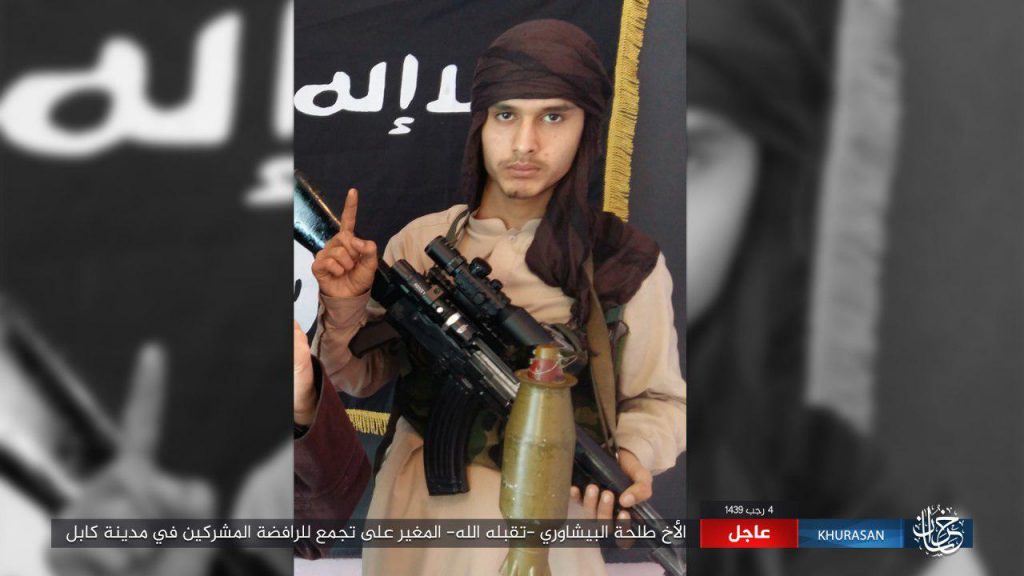
The Islamic State’s Khorasan “province” (also known as ISIS-K) has claimed responsibility for a suicide bombing near the Sakhi shrine in Kabul, Afghanistan earlier today. The jihadist group says 100 people were killed or injured in the bombing. The Afghan government reports that more than 30 people died and dozens more were wounded in the blast.
The Islamic State’s Amaq News Agency first took credit for the bombing in a short message. Its statement was followed by another from the so-called caliphate. The jihadists identified the bomber as Talha al-Peshawari, an alias indicating that he is probably from Pakistan.
The young suicide bomber intentionally struck the shrine as worshippers were celebrating Nowruz, the Persian New Year. In Afghanistan, as elsewhere, the Islamic State deliberately targets Shiites on special occasions and in their places of worship.
As FDD’s Long War Journalpreviously noted*, the United Nations Assistance Mission in Afghanistan (UNAMA) has documented a sharp uptick in the number of attacks on Shiite civilians and places of worship since early 2016. Such operations are a deliberate part of ISIS-K’s strategy, as the group seeks to stoke sectarian conflict.
In Nov. 2017, UNAMA issued a special report documenting jihadist operations targeting “places of worship, religious leaders and worshippers.” Prior to Jan. 2016, UNAMA reported, insurgents “rarely” carried out “deliberate attacks” against Shiite Muslims. There were just five such documented “incidents” between Jan. 1, 2009 and Dec. 31, 2015, and the “perpetrators and motives behind” those attacks was often unclear. Before 2016, the “only” mass casualty assault on a Shiite mosque occurred on Dec. 6, 2011, when a suicide bomber struck worshippers in the city of Kabul, killing 56 civilians and injuring 195 others. According to UNAMA, Lashkar-e-Jhangvi — an anti-Shiite, Sunni jihadist group —claimed responsibility for that bombing, but “this claim was never confirmed independently by UNAMA.”
With the emergence of ISIS-K, however, Shiite places of worship became a more frequent target.
UNAMA documented 12 such attacks between Jan. 1, 2016 and the end of Oct. 2017. These were “mainly claimed” by ISIS-K, which took responsibility for eight of the incidents. These 12 terrorist attacks resulted in “689 civilian casualties (230 deaths and 459 injuries).”
Four of the 12 operations were carried out in 2016, and the remaining eight during “the first 10 months of 2017,” according to UNAMA. One such heinous plot was executed on Oct. 11, 2016, when a suicide terrorist “armed with an AK-47 and hand grenades entered the Karte Sakhi Shi’a shrine and mosque in Kabul city during Ashura commemorations.” This is the same shrine targeted today. The ISIS-K jihadist “threw a grenade and opened fire against women, children and men inside the mosque, killing 19 civilians and injuring a further 60 before being killed by police.”
Earlier this month, UNAMA reported that the number of civilian deaths in Afghanistan decreased slightly in 2017, as compared to 2016, and the number of injuries also dropped. However, the total number civilian casualties remains near historic highs, with 10,453 people killed (3,438) or wounded (7,015) last year. While this was a nine per cent decline from 2016, the number of civilian casualties in 2017 was greater than in any year from 2009 until 2013.
Bombings such as the one carried out today, as well as other “complex” jihadist assaults, are among the leading causes of civilian deaths and injuries. The UN found that “[s]uicide and complex attacks caused 22 per cent of all civilian casualties in Afghanistan in 2017,” with “16 per cent of all civilian casualties during the year occurring from such attacks in Kabul city.”
That is, more than sixteen years into the Afghan war, the jihadists are still able to regularly evade security forces inside the capital.
The Islamic State’s Khorasan branch “claimed responsibility for 14 suicide and complex attacks in Kabul city” during 2017, according to the UN.
On Dec. 28, 2017, another ISIS-K suicide bomber blew himself up at the Tabayan cultural center in Kabul. The Islamic State sought to justify the bombing by arguing that the center is used to recruit Shiite militiamen for the wars in Iraq and Syria. The jihadists regularly hit other, non-religious targets inside the Afghan capital as well.
*FDD’s Long War Journalpreviously published summary of UNAMA’s Nov. 2017 special report in an article last year.
from Long War Journal – FDD's Long War Journal http://ift.tt/2IIqXng
via Defense News
No comments: